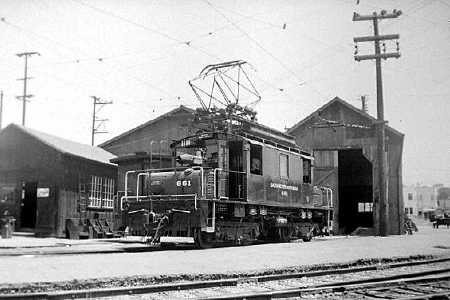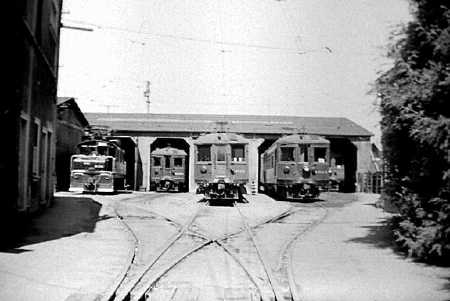OAKLAND'S 40TH & SHAFTER YARD
For 45 years, the Sacramento Northern's western operating hub was at 40th Street and Shafter Avenue in Oakland. This yard was tiny, but provided the Oakland, Antioch & Eastern Railway, successor San Francisco-Sacramento Railroad, and later the Sacramento Northern Railway, with nearly all the facilities the line needed to keep trains moving at the railroad's west end.

In May 1911, the Oakland & Antioch Railway purchased one complete city block and one-half block at the intersection of 40th Street and Shafter Avenue. The property fronted two blocks along 40th Street on either side of Shafter Avenue. The full block was to the east, bounded by Shafter Avenue, 40th Street, Opal Avenue and 41st Street. The property to the west included only the southern half of the block between Shafter and Webster Avenues, with the remainder facing 41st Street already developed as residential property. The rails approached the yard from the northeast via street running on Shafter Avenue. At 41st Street and Shafter Avenue, the track divided into a wye, with the Key System's 40th Street line forming the southern leg. By the time full service began in 1913, the yard was operated by the O&A's successor, the OA&E.

The railroad had originally planned a modest freight yard and shops at Rockridge on the east side of Oakland, but local opposition scuttled that plan. The OA&E was forced to stuff all their operations into their Shafter Avenue plot. As the western end of the line's freight operation, trains were received from, or made up for, Concord, Walnut Creek, and Sacramento. Cars were also interchanged here with the Oakland Terminal Railway, which served numerous industries along the Key System, and in later years reached the vital Oakland Army Base.

The wye's east leg divided into three short sidings running diagonally across the property, plus a single stub-ended spur (two spurs in later days). Working even the shortest trains required using the mainline on Shafter as a switching lead, which was soundly hated my most of the home owners along this otherwise quiet residential street. Stiff grades east of Oakland limited trains to a handful cars, and the few tracks were adequate (barely) for making up and breaking down those short trains. The railroad had no freight customers in Oakland with sidings, though some local businesses used the yard's spurs as team tracks to unload into drays or trucks. In later years a nearby building supply dealer rented space in the car house to store stacked lumber which may have been unloaded from boxcars or flatcars in the yard. A single spur served a modest freight house located on the southeast corner of 40th and Shafter. Until the early 1950s, less-than-carload freight made up an important part of the line's traffic, and at least one of the SNRY's wooden boxcars carrying LCL freight left here in almost every freight train, usually tucked directly behind the lead locomotives.

Except for dead-head movements, passenger trains rarely began or ended their runs here. The end of the line for passengers was the Key System ferry pier until 1939, then the San Francisco Transbay Terminal until all regular passenger service ended in 1941. There was little need for passenger cars to lay over in the yard, except when they were being serviced. Indeed, between runs most cars were stored in the Key System's yards. The scruffy and little-used 1200-class trailers were kept on a spur at Rockridge, appropriately beside the line's equally scruffy maintenance-of-way equipment.

The 40th and Shafter yard was an important transfer point between the Key System and the OA&E/SNRY for passengers arriving from and departing to Sacramento. These passengers were provided with a waiting room in a triangular building on the southwest corner of 40th and Shafter facing the wye's western leg. An interlocking tower on the second floor controlled the switches at the Key System junction on 40th Street, and also contained the dispatcher's office. Baggage and express were handled from a large brick building directly across the wye's double track west leg. Just across Shafter to the east, a small cafe housed in the end of the freight depot was available to both passengers and crew.

The yard also provided space for the modest shops that kept the OA&E's, and later the SF-S's, small fleet of equipment running smoothly. A corrugated iron building at the corner of 41st Street and Opal Avenue served as the first car repair shop. A single track ran inside the building. Though small, this shop was sophisticated enough to stretch, then later shorten, parlor car Sacramento, and to build box motor 607 from the ground up. Later this building became a paint shop, with repairs being handled in the car house. Next door, a slightly smaller shop took care of the line's locomotives.
On the diagonally opposite corner at 40th Street and Webster Avenue, the line built a five-track car house. The north and south walls were brick, but the east and west appear to have been clad with corrugated iron. The car house provided a covered space for repairs after the original repair building became a paint shop. The center lead track was provided with an outdoor inspection pit. A big extension cord was provided to move motors from areas inside that did not have overhead wire.
There were several other sheds and storage buildings tucked into odd corners of the property for lumber, spare parts and supplies. A small building near the center of the lot was originally used as an oil house, and contained crew lockers in later years.

A "portable" substation housed in former OA&E/SF-S boxcar 3005 was tucked away in a shed just outside the car house. A 1200-volt DC, 350-kilowatt unit, the substation fed power to the 1200-volt overhead which began at 42nd and Shafter. This substation was apparently not used during the all-freight era, and may have gone out of service as early as 1936 when the mainline pressure was raised to 1500 volts. Overhead wire within the yard area and on the Shafter Avenue lead was set at 600 volts DC, fed by an outdoor transformer located between the freight station and the oil house. A new 600 volt substation was built using a SN 2100 in 1938, an early 36' automobile boxcar (possibly of New York Central origin; "You wreck 'em, you buy 'em"). The new substation was tucked away inside the paint shop, where it hid from view for the next 21 years. When a westbound train cleared Havens, a bell would ring in the tower. This was the signal for the tower operator to start up the substation.
A small but unique feature often goes unnoticed in photographs. SN cabooses all carried batteries for lighting, at least in their later years. The batteries were charged between runs from the overhead wire. A crewman would climb onto the caboose roof and drape a hooked rod over the 600 volt wire, which was connected by wire to the batteries. The daring employee was supposedly protected from electrocution by a thick wooden handle on this contraption. A close look at many caboose photos taken in the yard will show this wooden handle floating in the air above the car.

The physical facilities at 40th and Shafter remained largely unchanged through the SF-S years. However, following the merger into the SNRY on January 1, 1929 (at 12:01 a.m., to be exact), all heavy repairs were moved to the Mulberry Shops at Chico. The end of passenger service in 1941 further reduced activity. Things heated up again during World War II, as huge amounts of military traffic required extra freight engines to be serviced here. Following the war years, the fledgling Bay Area Electric Railway Association stored some of their equipment in the car house. These relics included SN combine 1005, SN Birney streetcar 62, and Saskatoon streetcar 12.

During the 1950s, the Western Pacific was committed to phasing out SN's Oakland line, including the yard and shops, whenever a new route to the Oakland Army Base could be built. A connection between the WP and the OTRY was finally completed along Union Street in February 1957. The last SN train from Oakland ran on February 28, 1957, powered by General Electric steeple cab 652 with sister 653 as a pusher. The empty buildings were torn down over the next couple of years and were replaced by commercial and office buildings.

Some of the information in this story came from Ira Swett's SACRAMENTO NORTHERN. Donald Sims' article "Sacramento Northern Presents . . . a Yard to Model" in the fall 1959 MODEL TRAINS, was also used. Full citations may be found in our bibliography section. In addition, various Sanborn Fire Insurance Maps were consulted.

